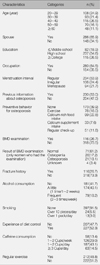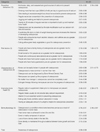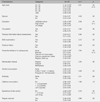Abstract
Purpose
This study was implemented to investigate the level of awareness of osteoporosis among urban women.
Methods
A survey was conducted with a sample size of 434 adult females who resided in metropolises in Korea such as Seoul, Gyeonggi-do, Pusan, Gyeongsangnam-do, Kangwon-do, Jeju-do and Jeollanam-do. Osteoporosis Awareness Scale was consisted of five areas with total number of 31 questions. The questionnaire's scale was 1 to 4 point, 4 point being the highest understanding level. The collected data were analyzed using descriptive statistics method.
Results
The average awareness level of subjects was 2.38 and significant different depending on participants' age, education level, previous encounter with any information about osteoporosis, preventive behavior of osteoporosis, bone mineral density test, fracture history, diet control experience, and regular exercise. In osteoporosis awareness level by five areas, preventive behaviors 2.76 resulted in the highest score and characteristics of osteoporosis 2.51, bone physiology 2.46, improving bone health 2.38, and risk factors 1.80 followed respectively.
Figures and Tables
References
1. Alexandraki K.I., Syriou V., Ziakas P.D., Apostolopoulos N.V., Alexandrakis A.I., Piperi C. The knowledge of osteoporosis risk factors in a Greek female population. Maturitas. 2008. 59(1):38–45.

2. Choi E.S., Kim J.H., Chung M.Y., Hwang K.H. Development of an osteoporosis awareness scale for women. J Korean Acad Nurs. 2008. 38(6):813–821.

3. Gemalmaz A., Oge A. Knowledge and awareness about osteoporosis and its related factors among rural Turkish women. Clin Rheumatol. 2008. 27(6):723–728.

4. Gordon P.M., Newcomer R.R., Krummel D.A. Physical activity and osteoporosis: Disparities between knowledge and practice. W V Med J. 2001. 97(3):153–156.
5. Judy A.G., Davis P. A prospective evaluation of the awareness, knowledge, risk factors and current treatment of osteoporosis in a cohort of elderly subjects. Osteoporosis Int. 2001. 12(8):617–622.
6. Kang H.Y., Kang D.R., Jang Y.H., Park S.E., Choi W.J., Moon S.H. Estimating the ecologic burden of osteoporotic vertebral fracture among elderly Korean women. J Prev Med Public Health. 2008. 41(5):287–294.
7. Kang Y.M. A study on the relationships between osteoporosis knowledge. health belief and self efficacy of middle aged women. 1998. Seoul: Ewha Woman University;Unpublished master's thesis.
8. Kim J.S., Kim M.H., Shin J.S. Effects of weight-bearing exercise on bone metabolism in college women. J Korean Acad Nurs. 2004. 34(5):760–770.

9. Kim M.H., Kim M.S. A study on the relationships between knowledge about osteoporosis and cognitive factors in middle-aged women. Korean J Women Health Nurs. 2005. 11(1):52–57.

10. Kjaerbye-Thygesen A., Munk C., Ottesen B., Kruger Kjaer S. Why do slim women consider themselves too heavy? A charaterization of adult women considering their body weight as too heavy. Int J Eat Disord. 2004. 35(3):275–285.
11. Health behavior and chronic disease statistics. Korea Center for Disease Control and Prevention. 2006. Retrieved September 10, 2009. from
http://www.cdc.go.kr/.
12. Lee H.Y. A study of correlation among the knowledge of the disease health promoting behaviors and the quality of life in the female patients with osteoporosis. 2001. Seoul: Kyung Hee University;Unpublished master's thesis.
13. Lee H.Y., Kim S.Y. The effect of education for prevention of osteoporosis patients with bone fracture. J Korean Acad Nurs. 2001. 31(2):194–205.

14. Lee J.K. The effect of the knowledge and health beliefson osteoporosis preventive health behaviors among middle-aged women. J Korean Acad Community Health Nurs. 2003. 14(4):14–24.
15. Ministry of Health and Welfare. Identification of characteristics and pathogenesis of osteoporosis in Korea and search for new drugs (Report of Health Medicine Technical Infra Development Project). 2005. Seoul: Author.
16. Moon E.S. A study on the relationship among knowledge of fracture a prevention, health belief, and fracture prevention behaviors in patients with osteoporosis. 2008. Gwangju: Cheonnam National University;Unpublished master's thesis.
17. Motkovic V., Jelic T., Wardlaw G.M., Ilich J.Z., Goel P.K., Wright J.K. Timing of peak bone mass in Caucasian females and its implication for the prevention of osteoporosis. J Clin Invest. 1994. 93(2):799–808.
18. Fast facts on osteoporosis. National Osteoporosis Foundation Data. 2008. Retrieved March 30, 2008. from
http://www.nof.org/osteoporosis/diseasefacts.htm#National.
19. Oh K.W. Osteoporosis. Korean J Med. 2008. 75(3):267–273.
20. Pande K.C., de Takats D., Kanis J.A., Edwards V., Slade P., McCloskey E.V. Development of a questionnaire (OPQ) to assess patient's knowledge about osteoporosis. Maturitas. 2000. 37:75–81.

. Park C.Y. A study on the relationships between osteoporosis knowledge, health belief, self-efficacy, and bone mineral density of middle aged and elderly woman in urban city. 2007. Seoul: Ewha woman University;Unpublished master's thesis.
22. Park J.H., Joe H.G., Kim J.Y., Kim T.Y., Lee J.A., Kim J.S. Recognition of osteoporosis and analysis of influencing factors. Korean J Fam Med. 2004. 25(7):542–549.
23. Rubin L.A., Hawker G.A., Peltekova V.D., Fielding L.J., Ridout R., Cole D.E. Determinants of peak bone mass: Clinical and genetic analysis in young female Canadian cohort. J Bone Miner Res. 1999. 14(4):633–643.
24. Satterfield T., Johnson S.M., Slovic P., Neil N., Schein J.R. Perceived risks and reported behaviors associated with osteoporosis and its treatment. Women Health. 2000. 31(4):21–40.

25. Shin S.J., Shin K.R., Yi H.R., Ju S.K. Knowledge, health belief, and self-efficacy related to osteoporosis. J Korean Acad Nurs. 2005. 35(5):850–857.

26. Sin C.S., Jo N.H., Kim Y., Kim S.W., Park J.H., Kim M.H., Kim I.G. Study of an osteoporosis management program in Korea. 2007. Unpublished manuscript,Seoul National University.
27. Sun K.S. The effect of web-based osteoporosis prevention program on the osteoposis knowledge, self efficacy, health belief, stage of change on female college student. 2003. Gwangju: Cheonnam National University;Unpublished doctoral dissertation.
28. World Health Organization. WHO study group on assessment of fracture risk and its application to screening for postmenopausal osteoporosis (Technical Report No. 843). 1994. Geneva, Switzerland: Author.
29. Yeon E.J. A study on knowledge and practices about osteoporosis in adults. Korean J Rehabil Nurs. 2001. 1(1):27–42.




 PDF
PDF ePub
ePub Citation
Citation Print
Print








 XML Download
XML Download